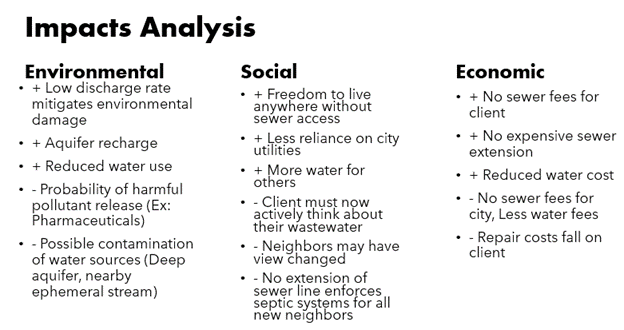

An analysis of the final recommendation has been made to understand its impact on several sectors. Commonly referred to as a ‘Triple Bottom Line Analysis’, this analysis focuses on finding environmental, economic, and social impacts the system may have. Impacts are not always negative, and further discussion will include both positive and negative impacts.
The most major sector the system will affect will be environmental impacts. Septic systems, and with that nearly all on-site wastewater treatment systems, must ensure the environment is not harmed by the disposal of their effluent. Such systems can sometimes negatively affect the environment as they release chemicals into the earth, as well as other harmful pollutants like pharmaceuticals and plastics. Since these are released into the soil on-site, another negative environmental impact comes from contamination of water sources. Water could make it to the nearby ephemeral stream or the deep aquifer untreated, which could cause damage.
However, the positive environmental impacts of such a system are quite important as well. The main positive impact comes from the fact that treating the water in this way is better than simply dumping untreated wastewater into the environment. For any of the systems above, water is also allowed to percolate down into the earth, where it is treated, before it reaches natural water tables, meaning that such systems help, on a long-time scale, to replenish aquifers. In keeping with water use, the other major positive impact includes the fact that the system will help the client reduce their use of potable water for gardening, and instead use recycled water to do so. This reduction in water consumption is a major positive environmental impact.
For economic impacts, these all mainly influence locals alone. For the clients, they have no need to worry about paying for a sewer line extension to their home, which would be very cost prohibitive for them. Additionally, the clients also have less water consumption, which means less of a water bill for them to pay. These are both very positive impacts that mainly only affect the client. Finally, small businesses focusing on septic tank maintenance and pumping will receive the client as additional customers.
However, on the flip side, the negatives affect both the client and the local municipality of Dewey-Humboldt. Since this system allows the clients to not participate in a city sewer line, no taxes or bills are being paid by the client to the city. While this may be positive for the client, it’s a negative for the city as these payments are how such sewer lines are paid for and maintained. The other major negative impact is that if the system fails, the client is completely responsible for repair cost, which could be a difficult economic burden.
Social impacts very greatly depending on whether the focus is on the client, on neighbors, or on the city. Negative impacts most importantly include the fact that the clients must now actively think about their wastewater as they are in charge of maintaining the system. Wastewater can be seen as disgusting to many, so the client will need to deal with this. Neighbors may be negatively affected as the construction of a new house may obstruct a desirable view. Finally, since the client isn’t paying for a sewer line extension, other new neighbors must also be forced to use a septic system unless they foot the cost of the sewer line extension.
There are positive social impacts as well. The client has the freedom to live wherever they wish without requiring sewer access. The client is also less reliant on city utilities in general, which may bring peace of mind. Leach field outputs could enhance plant growth and beautify the area if well-tended (and ensured to not interfere with the system). Finally, since the system helps reduce the client’s water use, there is more water to go around for other people.
Last Updated 12/12/2022